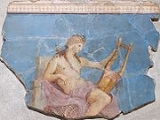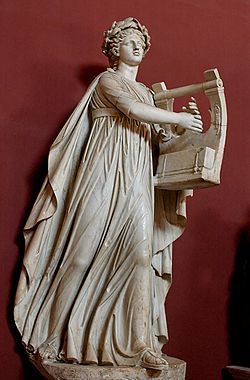
Apollo Citharoedus
Encyclopedia
An Apollo Citharoedus, or Apollo Citharede, designates a statue or other image of Apollo
with cithara
(lyre). Among the best-known realizations of this aspect of Apollo is the Apollo Citharoedus of the Vatican Museums
, a 2nd century AD colossal marble statue of by an unknown Roman sculptor (illustration, left). Apollo is shown crowned with laurel
and wearing the long, flowing robe of the Ionic bard. The statue was found in 1774, with seven statues of the Muses in the ruins of Gaius Cassius Longinus
' villa near Tivoli, Italy
; the sculptures are preserved in the Hall of the Muses, in the Museo Pio-Clementino of the Vatican Museums
.
A marble sculpture now identified as Pothos following a lost Greek 4th-century BC original by Skopas was restored as an Apollo Citharoedus; it is conserved in the Great Hall of the Palazzo Nuovo, Capitoline Museums
, Rome. Another marble Apollo Citharoedus (2.29m), from a Hellenistic original attributed to Timarchides, of the 2nd century BC, also stands in the Great Hall of the Palazzo Nuovo.
 Other examples include the Apollo of Mantua
Other examples include the Apollo of Mantua
and the Apollo Barberini
, possibly a copy of the cult statue of the Temple of Apollo Palatinus
; it is conserved in the Glyptothek
, Munich
Apollo
Apollo is one of the most important and complex of the Olympian deities in Greek and Roman mythology...
with cithara
Kithara
The kithara or cithara was an ancient Greek musical instrument in the lyre or lyra family. In modern Greek the word kithara has come to mean "guitar" ....
(lyre). Among the best-known realizations of this aspect of Apollo is the Apollo Citharoedus of the Vatican Museums
Vatican Museums
The Vatican Museums , in Viale Vaticano in Rome, inside the Vatican City, are among the greatest museums in the world, since they display works from the immense collection built up by the Roman Catholic Church throughout the centuries, including some of the most renowned classical sculptures and...
, a 2nd century AD colossal marble statue of by an unknown Roman sculptor (illustration, left). Apollo is shown crowned with laurel
Bay Laurel
The bay laurel , also known as sweet bay, bay tree, true laurel, Grecian laurel, laurel tree, or simply laurel, is an aromatic evergreen tree or large shrub with green, glossy leaves, native to the Mediterranean region. It is the source of the bay leaf used in cooking...
and wearing the long, flowing robe of the Ionic bard. The statue was found in 1774, with seven statues of the Muses in the ruins of Gaius Cassius Longinus
Gaius Cassius Longinus
Gaius Cassius Longinus was a Roman senator, a leading instigator of the plot to kill Julius Caesar, and the brother in-law of Marcus Junius Brutus.-Early life:...
' villa near Tivoli, Italy
Tivoli, Italy
Tivoli , the classical Tibur, is an ancient Italian town in Lazio, about 30 km east-north-east of Rome, at the falls of the Aniene river where it issues from the Sabine hills...
; the sculptures are preserved in the Hall of the Muses, in the Museo Pio-Clementino of the Vatican Museums
Vatican Museums
The Vatican Museums , in Viale Vaticano in Rome, inside the Vatican City, are among the greatest museums in the world, since they display works from the immense collection built up by the Roman Catholic Church throughout the centuries, including some of the most renowned classical sculptures and...
.
A marble sculpture now identified as Pothos following a lost Greek 4th-century BC original by Skopas was restored as an Apollo Citharoedus; it is conserved in the Great Hall of the Palazzo Nuovo, Capitoline Museums
Capitoline Museums
The Capitoline Museums are a group of art and archeological museums in Piazza del Campidoglio, on top of the Capitoline Hill in Rome, Italy. The museums are contained in three palazzi surrounding a central trapezoidal piazza in a plan conceived by Michelangelo Buonarroti in 1536 and executed over...
, Rome. Another marble Apollo Citharoedus (2.29m), from a Hellenistic original attributed to Timarchides, of the 2nd century BC, also stands in the Great Hall of the Palazzo Nuovo.

Apollo of Mantua
The Apollo of Mantua and its variants are early forms of the Apollo Citharoedus statue type, in which the god holds the cithara in his left arm...
and the Apollo Barberini
Apollo Barberini
The Apollo Barberini is a 1st–2nd century Roman sculpture of Apollo Citharoedus. It is a probable copy of the sculpture of Apollo Citharoedus that was the cult statue in the temple of Apollo Palatinus in Rome.It is named after the Barberini who acquired it. It is now held in the Munich...
, possibly a copy of the cult statue of the Temple of Apollo Palatinus
Temple of Apollo Palatinus
The Temple of Apollo Palatinus was a temple on the Palatine Hill of ancient Rome, which was first dedicated by Augustus to his patron god Apollo. It was only the second temple in Rome dedicated to the god, after the Temple of Apollo Sosianus...
; it is conserved in the Glyptothek
Glyptothek
The Glyptothek is a museum in Munich, Germany, which was commissioned by the Bavarian King Ludwig I to house his collection of Greek and Roman sculptures . It was designed by Leo von Klenze in the Neoclassical style, and built from 1816 to 1830...
, Munich

